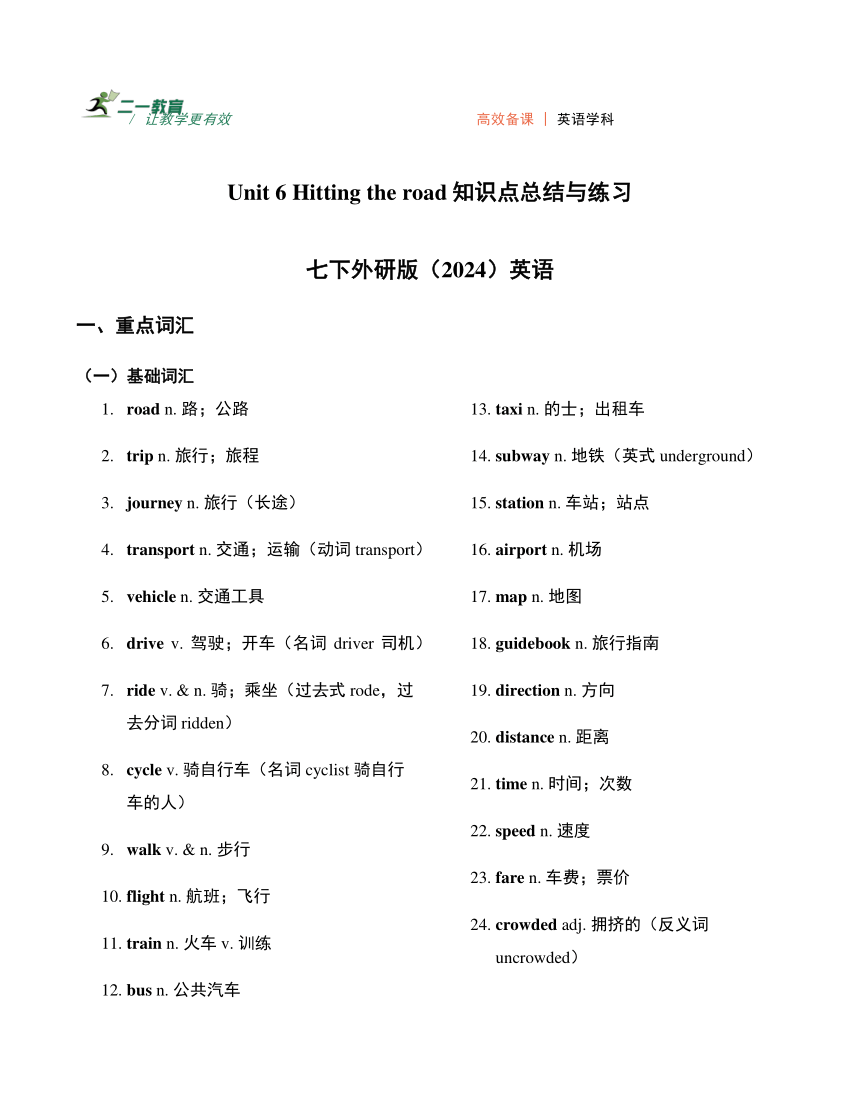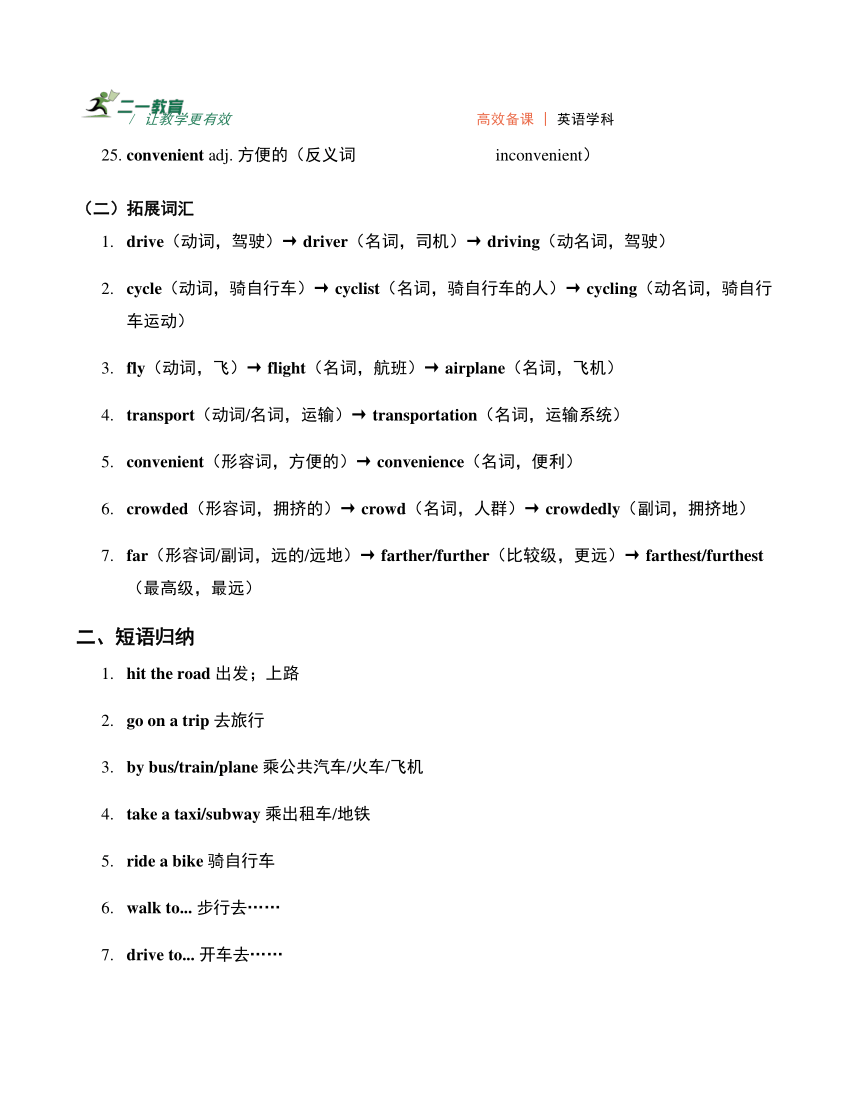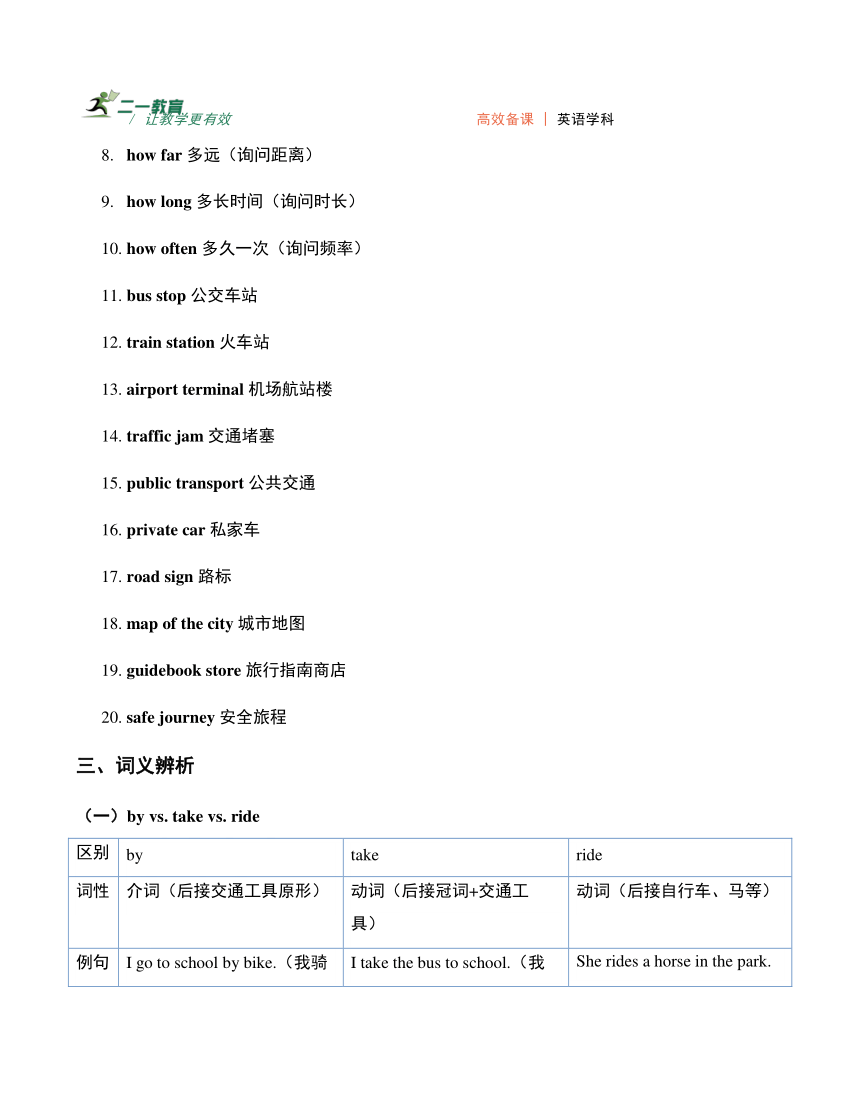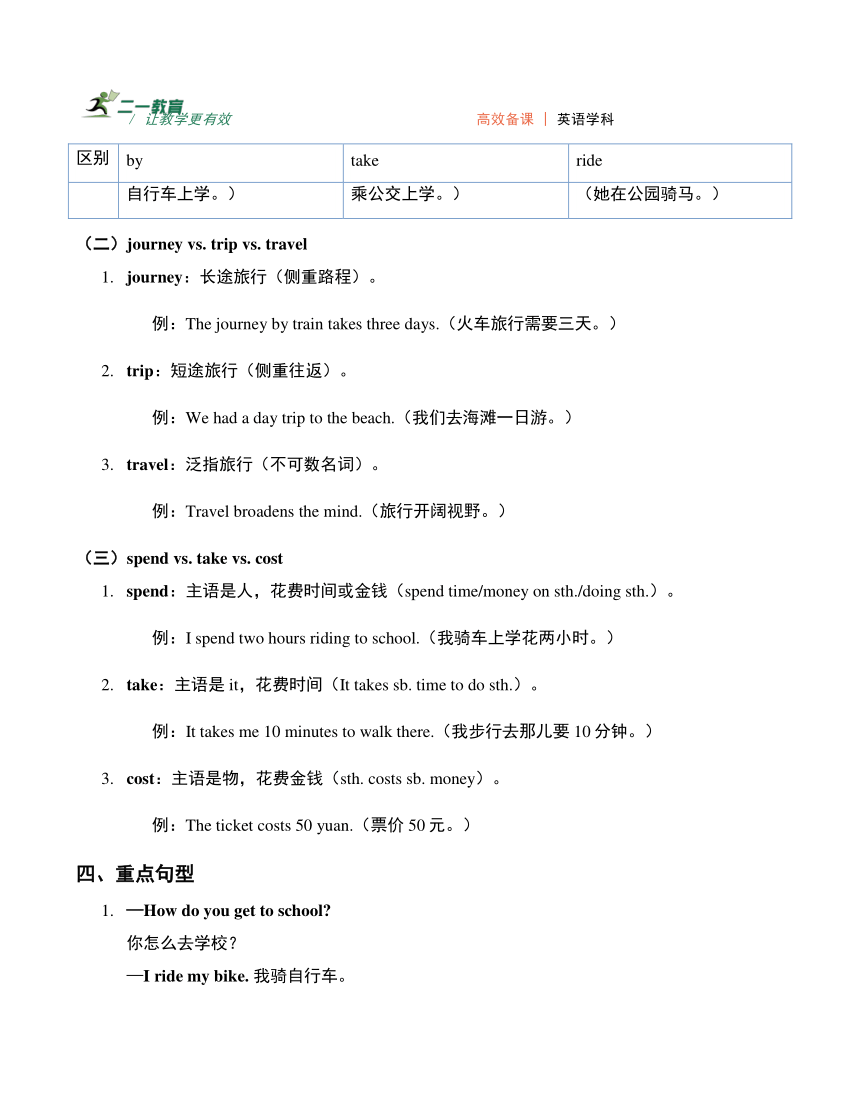Unit 6 Hitting the road 知识点总结与练习(含答案解析) 七下外研版(2024)英语
文档属性
| 名称 | Unit 6 Hitting the road 知识点总结与练习(含答案解析) 七下外研版(2024)英语 |  | |
| 格式 | docx | ||
| 文件大小 | 43.8KB | ||
| 资源类型 | 试卷 | ||
| 版本资源 | 外研版 | ||
| 科目 | 英语 | ||
| 更新时间 | 2025-05-16 08:26:38 | ||
图片预览





文档简介
Unit 6 Hitting the road知识点总结与练习
七下外研版(2024)英语
一、重点词汇
(一)基础词汇
/ 让教学更有效 高效备课 | 英语学科
road n. 路;公路
trip n. 旅行;旅程
journey n. 旅行(长途)
transport n. 交通;运输(动词 transport)
vehicle n. 交通工具
drive v. 驾驶;开车(名词 driver 司机)
ride v. & n. 骑;乘坐(过去式 rode,过去分词 ridden)
cycle v. 骑自行车(名词 cyclist 骑自行车的人)
walk v. & n. 步行
flight n. 航班;飞行
train n. 火车 v. 训练
bus n. 公共汽车
taxi n. 的士;出租车
subway n. 地铁(英式 underground)
station n. 车站;站点
airport n. 机场
map n. 地图
guidebook n. 旅行指南
direction n. 方向
distance n. 距离
time n. 时间;次数
speed n. 速度
fare n. 车费;票价
crowded adj. 拥挤的(反义词 uncrowded)
convenient adj. 方便的(反义词 inconvenient)
(二)拓展词汇
drive(动词,驾驶)→ driver(名词,司机)→ driving(动名词,驾驶)
cycle(动词,骑自行车)→ cyclist(名词,骑自行车的人)→ cycling(动名词,骑自行车运动)
fly(动词,飞)→ flight(名词,航班)→ airplane(名词,飞机)
transport(动词/名词,运输)→ transportation(名词,运输系统)
convenient(形容词,方便的)→ convenience(名词,便利)
crowded(形容词,拥挤的)→ crowd(名词,人群)→ crowdedly(副词,拥挤地)
far(形容词/副词,远的/远地)→ farther/further(比较级,更远)→ farthest/furthest(最高级,最远)
二、短语归纳
hit the road 出发;上路
go on a trip 去旅行
by bus/train/plane 乘公共汽车/火车/飞机
take a taxi/subway 乘出租车/地铁
ride a bike 骑自行车
walk to... 步行去……
drive to... 开车去……
how far 多远(询问距离)
how long 多长时间(询问时长)
how often 多久一次(询问频率)
bus stop 公交车站
train station 火车站
airport terminal 机场航站楼
traffic jam 交通堵塞
public transport 公共交通
private car 私家车
road sign 路标
map of the city 城市地图
guidebook store 旅行指南商店
safe journey 安全旅程
三、词义辨析
(一)by vs. take vs. ride
区别 by take ride
词性 介词(后接交通工具原形) 动词(后接冠词+交通工具) 动词(后接自行车、马等)
例句 I go to school by bike.(我骑自行车上学。) I take the bus to school.(我乘公交上学。) She rides a horse in the park.(她在公园骑马。)
(二)journey vs. trip vs. travel
journey:长途旅行(侧重路程)。
例:The journey by train takes three days.(火车旅行需要三天。)
trip:短途旅行(侧重往返)。
例:We had a day trip to the beach.(我们去海滩一日游。)
travel:泛指旅行(不可数名词)。
例:Travel broadens the mind.(旅行开阔视野。)
(三)spend vs. take vs. cost
spend:主语是人,花费时间或金钱(spend time/money on sth./doing sth.)。
例:I spend two hours riding to school.(我骑车上学花两小时。)
take:主语是it,花费时间(It takes sb. time to do sth.)。
例:It takes me 10 minutes to walk there.(我步行去那儿要10分钟。)
cost:主语是物,花费金钱(sth. costs sb. money)。
例:The ticket costs 50 yuan.(票价50元。)
四、重点句型
—How do you get to school
你怎么去学校?
—I ride my bike. 我骑自行车。
—How far is it from your home to school
从你家到学校有多远?
—It’s about two kilometers. 大约两公里。
—How long does it take to get there by bus
乘公交到那儿要多久?
—It takes about 30 minutes. 大约30分钟。
Taking the subway is convenient, but it’s always crowded.
乘地铁很方便,但总是很拥挤。
She drives to work every day because her office is far away.
她每天开车上班,因为办公室很远。
If you travel by plane, you can see the clouds clearly.
如果你乘飞机旅行,可以清楚看到云朵。
五、语法聚焦
(一)交通方式的表达
by + 交通工具(中间无冠词):by bike, by bus, by train。
take + a/the + 交通工具:take a taxi, take the subway。
ride/drive/fly + a + 交通工具:ride a bike, drive a car, fly a plane。
on foot(步行):I go to school on foot.
(二)How引导的特殊疑问句
How:询问方式(如何)。
例:How does she get to the airport (她怎么去机场?)
How far:询问距离(多远)。
例:How far is the station from here (车站离这儿多远?)
How long:询问时间长度或物体长度(多久/多长)。
例:How long does the journey take (旅程要多久?)
(三)一般现在时(表示经常性动作)
结构:主语 + 动词原形/第三人称单数 + 其他。
例:He takes the bus to work every day.(他每天乘公交上班。)
例:They often ride bikes on weekends.(他们周末常骑自行车。)
练习题
(一)词汇填空(根据首字母提示写单词)
We are going on a t______ to the mountains next week.
The d______ from my home to school is 1 kilometer.
I usually r______ my bike to the park on Sundays.
The a______ is far from the city, so we need to leave early.
Taking the s______ is the fastest way to get there.
(二)用所给词的适当形式填空
My father ______ (drive) me to school every morning.
How long does it ______ (take) to go to Beijing by train
There are many ______ (cyclist) in the bike lane.
The bus is too ______ (crowd), so I prefer walking.
She bought a ______ (guidebook) before her trip to London.
(三)单项选择
—______ do you go to work
—By car.
A. What B. How C. How far D. How long
It takes me 20 minutes ______ to school.
A. walk B. walks C. to walk D. walking
She lives far away, so she ______ the subway to work.
A. takes B. by C. rides D. drives
—______ is it from here to the museum
—About 5 kilometers.
A. How long B. How far C. How often D. How much
Riding a bike is ______ and good for the environment.
A. convenient B. crowded C. expensive D. far
(四)句型转换
I take the bus to school every day.(改为同义句)
I go to school ______ ______ every day.
It is 10 kilometers from my home to the park.(对划线部分提问)
______ ______ is it from your home to the park
She rides her bike to work.(改为一般疑问句)
______ she ______ her bike to work
The flight takes two hours.(对划线部分提问)
______ ______ does the flight take
Taking the train is interesting.(用动名词作主语改写)
______ the train ______ interesting.
(五)阅读理解
Many people choose different ways to travel. Some like taking the train because they can see beautiful views along the way. Others prefer planes for long journeys because they are fast. Riding a bike is popular among those who want to keep healthy and protect the environment.
Bob lives in the city. He goes to work by subway every day. “It’s convenient and cheap,” he says. Lily lives near her school, so she walks there every morning. “Walking makes me feel energetic,” she says.
No matter which way you choose, hitting the road can be full of fun!
Why do some people like taking the train
A. Because it’s fast. B. Because it’s cheap.
C. Because they can see views. D. Because it’s convenient.
How does Bob go to work
A. By bike. B. By subway. C. By bus. D. By car.
Why does Lily walk to school
A. Because her school is far. B. Because she likes walking.
C. Because she lives near school. D. Because walking is fast.
What is the passage mainly about
A. Different travel ways. B. How to choose a vehicle.
C. The convenience of subways. D. The fun of hitting the road.
(六)书面表达
假设你是李华,你的英国朋友Tom想了解你上学的交通方式。请你写一封邮件,内容包括:
你家到学校的距离和所需时间;
你选择的交通方式及原因(如方便、环保、锻炼等);
你对这种交通方式的感受。
提示重点短语:
how far
take + 交通工具
by bike/bus/subway
keep healthy
要求:60-80词,格式正确,语言通顺。
答案及解析
(一)词汇填空
【答案】trip
【解析】“去山区旅行”,go on a trip为固定短语,填trip。
【答案】distance
【解析】“距离1公里”,distance表示距离,填distance。
【答案】ride
【解析】“骑自行车”,ride my bike,填ride。
【答案】airport
【解析】“机场远离城市”,填airport。
【答案】subway
【解析】“乘地铁最快”,填subway。
(二)用所给词的适当形式填空
【答案】drives
【解析】主语father是第三人称单数,一般现在时动词加-s,填drives。
【答案】take
【解析】助动词does后接动词原形,填take。
【答案】cyclists
【解析】many后接可数名词复数,cyclist的复数为cyclists,填cyclists。
【答案】crowded
【解析】be动词后接形容词,crowd的形容词为crowded,填crowded。
【答案】guidebook
【解析】“一本旅行指南”,填单数guidebook。
(三)单项选择
【答案】B
【解析】询问交通方式用How,故选B。
【答案】C
【解析】It takes sb. time to do sth. 固定结构,填to walk,故选C。
【答案】A
【解析】“乘地铁”用take the subway,故选A。
【答案】B
【解析】询问距离用How far,故选B。
【答案】A
【解析】“方便且环保”,convenient符合语境,故选A。
(四)句型转换
【答案】by bus
【解析】take the bus = by bus,填by bus。
【答案】How far
【解析】对距离提问用How far,填How far。
【答案】Does; ride
【解析】一般现在时一般疑问句,主语she用does提问,动词还原为ride,填Does; ride。
【答案】How long
【解析】对时间长度提问用How long,填How long。
【答案】Riding; is
【解析】动名词作主语,谓语动词用is,填Riding; is。
(五)阅读理解
【答案】C
【解析】第一段“because they can see beautiful views along the way”,故选C。
【答案】B
【解析】第二段“He goes to work by subway every day”,故选B。
【答案】C
【解析】第二段“Lily lives near her school, so she walks there”,故选C。
【答案】A
【解析】文章介绍不同交通方式,主旨为A。
(六)书面表达(略)
(提示:开头问候,说明家到学校2公里,步行20分钟,选择步行因为环保且能锻炼,最后表达喜欢步行上学。)
七下外研版(2024)英语
一、重点词汇
(一)基础词汇
/ 让教学更有效 高效备课 | 英语学科
road n. 路;公路
trip n. 旅行;旅程
journey n. 旅行(长途)
transport n. 交通;运输(动词 transport)
vehicle n. 交通工具
drive v. 驾驶;开车(名词 driver 司机)
ride v. & n. 骑;乘坐(过去式 rode,过去分词 ridden)
cycle v. 骑自行车(名词 cyclist 骑自行车的人)
walk v. & n. 步行
flight n. 航班;飞行
train n. 火车 v. 训练
bus n. 公共汽车
taxi n. 的士;出租车
subway n. 地铁(英式 underground)
station n. 车站;站点
airport n. 机场
map n. 地图
guidebook n. 旅行指南
direction n. 方向
distance n. 距离
time n. 时间;次数
speed n. 速度
fare n. 车费;票价
crowded adj. 拥挤的(反义词 uncrowded)
convenient adj. 方便的(反义词 inconvenient)
(二)拓展词汇
drive(动词,驾驶)→ driver(名词,司机)→ driving(动名词,驾驶)
cycle(动词,骑自行车)→ cyclist(名词,骑自行车的人)→ cycling(动名词,骑自行车运动)
fly(动词,飞)→ flight(名词,航班)→ airplane(名词,飞机)
transport(动词/名词,运输)→ transportation(名词,运输系统)
convenient(形容词,方便的)→ convenience(名词,便利)
crowded(形容词,拥挤的)→ crowd(名词,人群)→ crowdedly(副词,拥挤地)
far(形容词/副词,远的/远地)→ farther/further(比较级,更远)→ farthest/furthest(最高级,最远)
二、短语归纳
hit the road 出发;上路
go on a trip 去旅行
by bus/train/plane 乘公共汽车/火车/飞机
take a taxi/subway 乘出租车/地铁
ride a bike 骑自行车
walk to... 步行去……
drive to... 开车去……
how far 多远(询问距离)
how long 多长时间(询问时长)
how often 多久一次(询问频率)
bus stop 公交车站
train station 火车站
airport terminal 机场航站楼
traffic jam 交通堵塞
public transport 公共交通
private car 私家车
road sign 路标
map of the city 城市地图
guidebook store 旅行指南商店
safe journey 安全旅程
三、词义辨析
(一)by vs. take vs. ride
区别 by take ride
词性 介词(后接交通工具原形) 动词(后接冠词+交通工具) 动词(后接自行车、马等)
例句 I go to school by bike.(我骑自行车上学。) I take the bus to school.(我乘公交上学。) She rides a horse in the park.(她在公园骑马。)
(二)journey vs. trip vs. travel
journey:长途旅行(侧重路程)。
例:The journey by train takes three days.(火车旅行需要三天。)
trip:短途旅行(侧重往返)。
例:We had a day trip to the beach.(我们去海滩一日游。)
travel:泛指旅行(不可数名词)。
例:Travel broadens the mind.(旅行开阔视野。)
(三)spend vs. take vs. cost
spend:主语是人,花费时间或金钱(spend time/money on sth./doing sth.)。
例:I spend two hours riding to school.(我骑车上学花两小时。)
take:主语是it,花费时间(It takes sb. time to do sth.)。
例:It takes me 10 minutes to walk there.(我步行去那儿要10分钟。)
cost:主语是物,花费金钱(sth. costs sb. money)。
例:The ticket costs 50 yuan.(票价50元。)
四、重点句型
—How do you get to school
你怎么去学校?
—I ride my bike. 我骑自行车。
—How far is it from your home to school
从你家到学校有多远?
—It’s about two kilometers. 大约两公里。
—How long does it take to get there by bus
乘公交到那儿要多久?
—It takes about 30 minutes. 大约30分钟。
Taking the subway is convenient, but it’s always crowded.
乘地铁很方便,但总是很拥挤。
She drives to work every day because her office is far away.
她每天开车上班,因为办公室很远。
If you travel by plane, you can see the clouds clearly.
如果你乘飞机旅行,可以清楚看到云朵。
五、语法聚焦
(一)交通方式的表达
by + 交通工具(中间无冠词):by bike, by bus, by train。
take + a/the + 交通工具:take a taxi, take the subway。
ride/drive/fly + a + 交通工具:ride a bike, drive a car, fly a plane。
on foot(步行):I go to school on foot.
(二)How引导的特殊疑问句
How:询问方式(如何)。
例:How does she get to the airport (她怎么去机场?)
How far:询问距离(多远)。
例:How far is the station from here (车站离这儿多远?)
How long:询问时间长度或物体长度(多久/多长)。
例:How long does the journey take (旅程要多久?)
(三)一般现在时(表示经常性动作)
结构:主语 + 动词原形/第三人称单数 + 其他。
例:He takes the bus to work every day.(他每天乘公交上班。)
例:They often ride bikes on weekends.(他们周末常骑自行车。)
练习题
(一)词汇填空(根据首字母提示写单词)
We are going on a t______ to the mountains next week.
The d______ from my home to school is 1 kilometer.
I usually r______ my bike to the park on Sundays.
The a______ is far from the city, so we need to leave early.
Taking the s______ is the fastest way to get there.
(二)用所给词的适当形式填空
My father ______ (drive) me to school every morning.
How long does it ______ (take) to go to Beijing by train
There are many ______ (cyclist) in the bike lane.
The bus is too ______ (crowd), so I prefer walking.
She bought a ______ (guidebook) before her trip to London.
(三)单项选择
—______ do you go to work
—By car.
A. What B. How C. How far D. How long
It takes me 20 minutes ______ to school.
A. walk B. walks C. to walk D. walking
She lives far away, so she ______ the subway to work.
A. takes B. by C. rides D. drives
—______ is it from here to the museum
—About 5 kilometers.
A. How long B. How far C. How often D. How much
Riding a bike is ______ and good for the environment.
A. convenient B. crowded C. expensive D. far
(四)句型转换
I take the bus to school every day.(改为同义句)
I go to school ______ ______ every day.
It is 10 kilometers from my home to the park.(对划线部分提问)
______ ______ is it from your home to the park
She rides her bike to work.(改为一般疑问句)
______ she ______ her bike to work
The flight takes two hours.(对划线部分提问)
______ ______ does the flight take
Taking the train is interesting.(用动名词作主语改写)
______ the train ______ interesting.
(五)阅读理解
Many people choose different ways to travel. Some like taking the train because they can see beautiful views along the way. Others prefer planes for long journeys because they are fast. Riding a bike is popular among those who want to keep healthy and protect the environment.
Bob lives in the city. He goes to work by subway every day. “It’s convenient and cheap,” he says. Lily lives near her school, so she walks there every morning. “Walking makes me feel energetic,” she says.
No matter which way you choose, hitting the road can be full of fun!
Why do some people like taking the train
A. Because it’s fast. B. Because it’s cheap.
C. Because they can see views. D. Because it’s convenient.
How does Bob go to work
A. By bike. B. By subway. C. By bus. D. By car.
Why does Lily walk to school
A. Because her school is far. B. Because she likes walking.
C. Because she lives near school. D. Because walking is fast.
What is the passage mainly about
A. Different travel ways. B. How to choose a vehicle.
C. The convenience of subways. D. The fun of hitting the road.
(六)书面表达
假设你是李华,你的英国朋友Tom想了解你上学的交通方式。请你写一封邮件,内容包括:
你家到学校的距离和所需时间;
你选择的交通方式及原因(如方便、环保、锻炼等);
你对这种交通方式的感受。
提示重点短语:
how far
take + 交通工具
by bike/bus/subway
keep healthy
要求:60-80词,格式正确,语言通顺。
答案及解析
(一)词汇填空
【答案】trip
【解析】“去山区旅行”,go on a trip为固定短语,填trip。
【答案】distance
【解析】“距离1公里”,distance表示距离,填distance。
【答案】ride
【解析】“骑自行车”,ride my bike,填ride。
【答案】airport
【解析】“机场远离城市”,填airport。
【答案】subway
【解析】“乘地铁最快”,填subway。
(二)用所给词的适当形式填空
【答案】drives
【解析】主语father是第三人称单数,一般现在时动词加-s,填drives。
【答案】take
【解析】助动词does后接动词原形,填take。
【答案】cyclists
【解析】many后接可数名词复数,cyclist的复数为cyclists,填cyclists。
【答案】crowded
【解析】be动词后接形容词,crowd的形容词为crowded,填crowded。
【答案】guidebook
【解析】“一本旅行指南”,填单数guidebook。
(三)单项选择
【答案】B
【解析】询问交通方式用How,故选B。
【答案】C
【解析】It takes sb. time to do sth. 固定结构,填to walk,故选C。
【答案】A
【解析】“乘地铁”用take the subway,故选A。
【答案】B
【解析】询问距离用How far,故选B。
【答案】A
【解析】“方便且环保”,convenient符合语境,故选A。
(四)句型转换
【答案】by bus
【解析】take the bus = by bus,填by bus。
【答案】How far
【解析】对距离提问用How far,填How far。
【答案】Does; ride
【解析】一般现在时一般疑问句,主语she用does提问,动词还原为ride,填Does; ride。
【答案】How long
【解析】对时间长度提问用How long,填How long。
【答案】Riding; is
【解析】动名词作主语,谓语动词用is,填Riding; is。
(五)阅读理解
【答案】C
【解析】第一段“because they can see beautiful views along the way”,故选C。
【答案】B
【解析】第二段“He goes to work by subway every day”,故选B。
【答案】C
【解析】第二段“Lily lives near her school, so she walks there”,故选C。
【答案】A
【解析】文章介绍不同交通方式,主旨为A。
(六)书面表达(略)
(提示:开头问候,说明家到学校2公里,步行20分钟,选择步行因为环保且能锻炼,最后表达喜欢步行上学。)
同课章节目录
